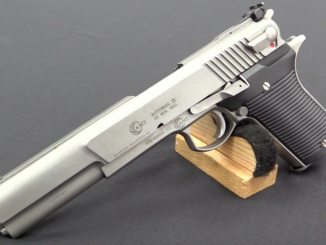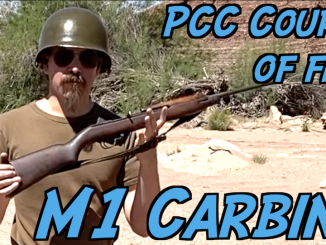The High Standard company only made on .45 caliber pistol, and it was an improvement on the Grant Hammond pistol tested by the US military during World War One. After his gun’s rejection by the military, it appears that Grant Hammond took the design to his friend “Gus” Swebelius who ran High Standard, to see if they could make it into a viable commercial product. The locking system was changed a bit and this prototype was made, but development and production ended there.
Related Articles

Semiauto pistol
AMT Automag IV – A Browning in .45 Winchester Magnum
The pistol in this video is coming up for auction here. The Automag series of pistol introduced by Arcadia Machine & Tool in the late 1980s and early 1990s were produced by the same man […]

Competition
M1 Carbine on the PCC Course of Fire
Today I am running an early-configuration M1 Carbine through my standardized Pistol-Caliber Carbine course of fire. This consists of a selection of cool target systems from MOA Targets – an 8-plate dueling tree, a mini-Mozambique, […]

Submachine Guns
Reising M55 SMG Video
The Reising series are some of the forgotten weapons the were formally adopted by the US military and used during WWII without getting much attention today, being overshadowed by the Thompson and M3 Grease Gun. […]

There was a sort-of coda to the Grant Hammond/High Standard story in the 1970s. Harry Sanford, a former High Standard VP, and Max Gera, a former High Standard engineer, apparently used the GH/HS patents (which even if granted had of course long since expired) as the overall basis for the original Auto Mag pistol;
https://en.wikipedia.org/wiki/Auto_Mag_Pistol
The major difference between the Grant Hammond and Auto Mag designs was that the Auto Mag adopted the rotating-bolt locking system of the 1896 Schwarzlose Standart automatic pistol, with a six-lug rifle-type bolt head.
Compare a Grant Hammond and Auto Mag side by side, and the resemblance is very obvious. Compare a field-stripped Auto Mag and a Schwarzlose side by side, and the internal similarities are even more so.
cheers
eon
You jive in perfectly with my own thought – the similarity is obvious, minus locking system as you said. So, Max Gera was probably not as such ‘genius’ as it first appeared. He just cleverly adopted preceding designs into his own novel solution.
“(…)not as such ‘genius’(…)just cleverly adopted preceding designs(…)”
Whilst inspiration is highly likely, it must be noted that Grant Hammond automatic pistols used much more moderate .45 Auto cartridge, than .44 AMP used in
https://modernfirearms.net/en/handguns/handguns-en/u-s-a-semi-automatic-pistols/amp-auto-mag-eng/
scaling itself weapon for much bigger (and different) cartridge is not easy tank.
Btw. if I gather it right, a company in South Carolina purchased rights to the marque. However, their final product is miles apart; it uses conventional tilting barrel instead of rotating bolt, thus saving barrel extension. I guess, it comes cheaper that way.
Think you may be conflating two different “successor” Auto Mags.
AMT (Arcadia Machine and Tool, one of Harry Sanford’s succession of post-Auto-Mag companies in California) introduced a series of “Automag [number]” pistols in the ’80s; these were all tilting-barrel actions, and I think they may be the ones you are thinking of. (AMT eventually got sold off, and production was moved to North Dakota, but to my knowledge never had anything to do with South Carolina.)
Recently (2015), a South Carolina company bought the rights to the original, no-number Auto Mag from Sanford’s heirs, and they’re currently getting it into production. While they claim to have made a number of changes (“improvements”, naturally) to the original design, it’s my understanding that it’s still the classic rotating-bolt action.
I meant the second. It is positively (and disappointedly) ‘flapper’.
In interviews with Gera, long after the original Auto-mag had been and gone
The inherent problems with the design get discussed.
They come down to the use of a separate light weight bolt and a barrel and slide assembly that only recoil for a short distance.
Even with the accelerator, momentum of the bolt is marginal
And bolt movement is too fast, necessitating other problem features such as stronger mag springs.
This is an issue with all pistols with this layout.
A Browning style slide (whether with a tilting or a rotating barrel) has the potential to provide much slower and more certain cycling, for the same weight of pistol or even a slightly lighter pistol.
Separate locking blocks (Walther and Beretta) or rollers (Vz 52) are just a nasty complication to the simple brilliance of the Browning slide.
Actually,they moved production to South Dakota at Sturgis.Unfortunately they were under capitalized and sold out again. I ended up with a bunch of their 1911 slides. I still have one in Commander length marked :.40 Smith and Wesson Commando”.Maybe someday I’ll mate it with some more parts.
Where’s the Closed Captions, Ian??
Really cool gun, but it has a lot of C96 mauser functionalities in the action. Bolt, assist to lock spring, spring in the bolt. That is what I saw…
This would make a great suppressor host. Fixed barrel just move front sight back some for threaded end on barrel. Or even integrally suppressed barrel setup.
Would be easy to build a slide lock to make it even quieter also. Replace slide lock screw with lever (with positive detent stops?).
Sounds like a good idea, but good luck convincing the Army to commission a suppressor for a .45 ACP barrel. The suppressors at the time were intended for snipers, training weapons, and pest control (rim-fire rifles and pistols). None of those were chambered for .45 ACP. The idea of a stealthy commando team’s silent pistol just didn’t appeal to the top brass at the time, as they were more interested in getting their entire field army to obtain the ultimate decisive victory (via artillery and rifle fire) to break through the lines, crush enemy morale by breaking through, and thus cause the enemy to throw down their guns and surrender! No sane enemy general surrenders to a bunch of guys disguised as bushes carrying “pest-control guns” in the middle of the night!
Looking at the High Standard version, it looks to me like not only does that “hook” effectively block the rear sight, it also looks like it’s the only thing keeping the bolt from coming straight back out of the barrel extension in recoil.
The original Grant Hammond had that boss on the side of the bolt riding in that slot extending from the ejector port. So there was little chance of a problem unless that boss sheared, which is unlikely at .45 ACP pressures/bolt velocities.
That hook might not have been so tolerant.
Note that the Schwarzlose and original Auto Mag both had a very large, hard steel vertical crossbolt extending upward from the lower receiver, that both cammed the bolt in and out of lockup and ensured that the bolt could not leave the rear of the barrel extension in recoil.
I can’t help but think that the High Standard pistol might be safe enough in .45 ACP, but questionable in 9 x 19mm. Rather like the Dreyse 1910 9mm automatic;
https://www.forgottenweapons.com/dreyse-1910-an-attempted-military-9mm-pistol/
cheers
eon
You clearly illustrate why it an also ran – being at the complex end of the type. With various bells and whistles of dubious-modest advantage. But ‘perhaps’ somewhat surprising that it not produced and / or adopted by somebody – given the insatiable WWI demand. Presumably just not worth the initial set up etc. costs v the projected market.
As seen in video, an upward lug over the locking block, locating through a longitudinal channel cut under the bolt front section, limits and blocks ite back travel. When taken down, lowering the front of locking block frees the bolt. The locking block seems rotatably pinned by a thin screw into the upper receiver and security against the bolt thrown off, based upon this pin’s durability. IMHO…
I noticed that too. Kind of flimsy IMHO.
Hi Denny, there it seems two shallow screws at both sides rather than a single pin crossing transversely…